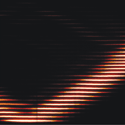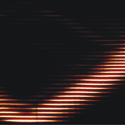A light beam passes through it
Abrupt interfaces disrupt wave propagation. For example, light passing from air into a sheet of glass will partially reflect backwards. When the light exits back into air, there is a second reflection that can cancel the first for light of just the right frequency, given the refractive index and thickness of the sheet. The wave nature of electrons creates similar effects when they encounter a region with a changing electrostatic potential. But early in the history of quantum mechanics, theorists realized that certain smoothly varying potential profiles could eliminate the reflection of electrons over a wide range of frequencies.
As it turns out, the same concepts work for light: intense light pulses known as solitons create precisely this kind of profile in the refractive index of the surrounding medium, eventually becoming trapped. Creating permanent versions of such “reflectionless potentials” has, however, proved difficult. In Physical Review Letters, Alexander Szameit of the Technion in Haifa, Israel, and colleagues in Germany and Australia at last implement the lack of light reflection in the laboratory.
In their experiments, a beam of light travels along an array of closely spaced, parallel waveguides created in a glass sample through direct laser-writing. By changing the spacing between some of the waveguides, the researchers construct a stripe along the length of the array that has a different refractive index modulation relative to the rest of the array. For almost any change in spacing, light traveling diagonally across the stripe is partially reflected, as usual. But a stripe having the special variation suggested by theory generates almost no reflection. The technique adds to the bag of tricks that researchers have for manipulating light. – Don Monroe





